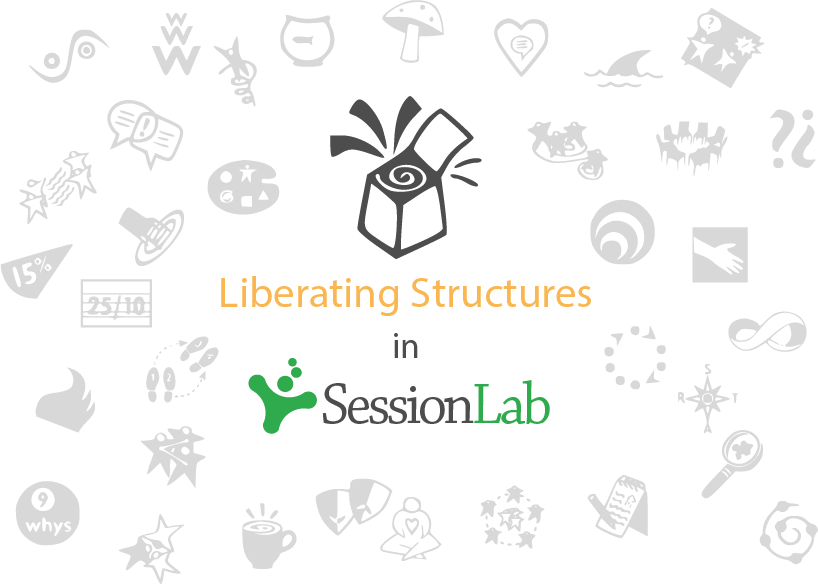Liberating Structures now in SessionLab Library

Simple rules that make it easy to include and unleash everyone in shaping the future (or at least the next meeting)
Keith McCandless and Henri Lipmanowicz sure had these kind of impressions and questions in their minds when they met in 2003 at Plexus Institute. They both had background in complexity science, improving organization’s workflow and learning methods. They shared a hunch that conventional structures (reports, presentations etc.) are too inhibiting while other techniques (brainstorming) are too loose. So building on a few methods they created Liberating Structures (the term itself is based on theory of power by William Torbert) that incorporates principles from complexity science, organizational development, improvisational arts, and user experience.The aim of Liberating Structures is to enhance creativity, trust and relational coordination while making every participant feel included and heard in meetings. The methodology follows the principle that attracting (rather than compelling) lively participation generates momentum for change and innovation. It is known that if you give everyone a choice of many innovative methods (without the pressure of a top-down “best practices”) then innovation will flourish. With the help of 34 easy-to-learn methods, you will be able to structure the way people interact with each other, leaving more room to the content. Liberating Structure methods help to make the process more explicit and understandable for everyone since it increases the ownership of solutions by including large groups of people. If used regularly, these methods will make meetings easier and more effective resulting in practices that have a meaning for everyone.
For example, when it comes to law and lawmaking sessions, the last thing we would think about is that it could be transformed into a discussion that is effective, simple, and involves everyone. Still, the latter happened when one lawyer introduced a couple of Liberating Structures methods during a conference on children’s justice issue. He began to plan the session by using Design Storyboard to draw out all the different activities.
Design StoryBoards – Advanced #team #liberating structures #team effectiveness #meeting design
You can avoid many of the traps that turn transformation initiatives and innovation projects into failures: the lack of a clear and common purpose, overall and for every stage of the initiative; inadequate engagement and participation; voices that are essential but not included; frustrated participants and nonparticipants; resistance to change; groupthink; nightmarish implementation for a disproportionally small impact.
A comprehensive design is a series of basic designs (see Design StoryBoards–Basic) linked together over a period of time. The design unfolds iteratively over days, weeks, months, or sometimes years depending on the scale of the project. Small cycles of design operate within larger cycles, scaling up and out as the initiative proceeds. You can easily include more people and more diversity in the design group for larger-scale projects. You can reflect the twists and turns in a transformation or innovation effort by a careful and ad hoc selection of participants (including unusual suspects since they are often the source of novel approaches).
Then introduced Impromptu Networking as an icebreaker to start the workshop. It raised the energy level and kicked off the conversation between participants.
Impromptu Networking #action #liberating structures #ice breaker
You can tap a deep well of curiosity and talent by helping a group focus attention on problems they want to solve. A productive pattern of engagement is established if used at the beginning of a working session. Loose yet powerful connections are formed in 20 minutes by asking engaging questions. Everyone contributes to shaping the work, noticing patterns together, and discovering local solutions.
With Social Network Webbing he showed that all of the participants have network or collaboration opportunities.
Social Network Webbing #team #liberating structures #visual mapping #connection
Social Network Webbing quickly illuminates for a whole group what resources are hidden within their existing network of relationships and what steps to take for tapping those resources. It also makes it easy to identify opportunities for building stronger connections as well as new ones.
The inclusive approach makes the network visible and understandable to everybody in the group simultaneously. It encourages individuals to take the initiative for building a stronger network rather than receiving directions through top-down assignments. Informal or loose connections—even your friends’ friends—are tapped in a way that can have a powerful influence on progress without detailed planning and big investments.
At the end 1-2-4-All provided a great platform to discuss the leadership challenges all lawmakers face at some point in their career.
1-2-4-All #idea generation #liberating structures #explore and understand
You can immediately include everyone regardless of how large the group is. You can generate better ideas and more of them faster than ever before. You can tap the know-how and imagination that is distributed widely in places not known in advance.
Open, generative conversation unfolds. Ideas and solutions are sifted in rapid fashion. Most importantly, participants own the ideas, so follow-up and implementation is simplified. No buy-in strategies needed! Simple and elegant!
You can find other intriguing case studies on the official Liberating Structures website.
Do you want to run a session using Liberating Structures methods?
The great news is, you don’t have to take special courses, or be certified Liberating Structures facilitator to use them. The methods are deliberately simple and anyone can lead a session by applying them. Just check out Liberating Structures in SessionLab and start shaping your organization’s future.
If you are eager to find out more about the background of the methods or the community behind them, visit the official website to find more inspiration, case studies and practical tips how to build the Liberating Structures on each other.



Leave a Comment